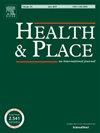Public space and loneliness in young adults in the Netherlands: An experiment with virtual environments
IF 4.1
2区 医学
Q1 PUBLIC, ENVIRONMENTAL & OCCUPATIONAL HEALTH
引用次数: 0
Abstract
As levels of loneliness in young adults are increasing, it is important to design loneliness reducing interventions for this age group. In this study, we specifically focus on built environment interventions that could alleviate young adults’ momentary feelings of emotional loneliness. We used an online survey incorporating a stated preference experiment with virtual public spaces in which seven attributes (presence of people, grass, water, benches, trees, vertical greenery, and traffic volume) were varied systematically. Respondents reported their momentary emotions (safe, relaxed, excited) and feelings of emotional loneliness after each video. The data were analyzed with regression models to determine the separate effects of these seven public space attributes on momentary loneliness and emotions. The results indicate that state loneliness is affected by the presence of other people in public space, as well as by the presence of trees and grass. Trees and other green elements (grass, water, vertical green), but also the presence of people have positive effects on feelings of safety, relaxation, and excitement. Public spaces with well-designed green elements and spaces that encourage liveliness can therefore contribute to reduced state loneliness, positive emotions and enhanced well-being.
公共空间与荷兰年轻人的孤独感:虚拟环境实验
随着年轻人孤独感的增加,为这个年龄组设计减少孤独感的干预措施是很重要的。在本研究中,我们特别关注建筑环境干预可以缓解年轻人的瞬间情感孤独感。我们使用了一项在线调查,结合了对虚拟公共空间的陈述偏好实验,其中七个属性(人、草、水、长凳、树木、垂直绿化和交通量)系统地变化。受访者报告了他们在每个视频后的瞬间情绪(安全、放松、兴奋)和情感上的孤独感。利用回归模型对数据进行分析,以确定这七个公共空间属性对瞬间孤独感和情感的单独影响。结果表明,状态孤独受公共空间中其他人的存在以及树木和草的存在的影响。树木和其他绿色元素(草、水、垂直绿色),以及人的存在对安全感、放松感和兴奋感都有积极的影响。因此,设计良好的绿色元素和鼓励活力的公共空间有助于减少状态孤独,积极情绪和增强幸福感。
本文章由计算机程序翻译,如有差异,请以英文原文为准。
求助全文
约1分钟内获得全文
求助全文
来源期刊

Health & Place
PUBLIC, ENVIRONMENTAL & OCCUPATIONAL HEALTH-
CiteScore
7.70
自引率
6.20%
发文量
176
审稿时长
29 days
期刊介绍:
he journal is an interdisciplinary journal dedicated to the study of all aspects of health and health care in which place or location matters.
 求助内容:
求助内容: 应助结果提醒方式:
应助结果提醒方式:


